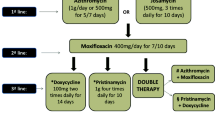Summary
The aim of this study was to examine whether a vaginalEscherichia coli colonization, mimicking the one seen in UTI-prone females, could be induced by amoxicillin administration. In adult cynomolgus monkeys, who carry the alpha-Gal-1-4-beta-Gal receptor for P-fimbriae, we have investigated the ability of a clinical isolate of P-fimbriatedE. coli to colonize the mucous membranes of the genital tract. When the vagina was washed with a suspension of the P-fimbriated strain, a persistent colonization was obtained in only 17% (4/24) of the experiments. When such colonization attempts were performed during vaginal amoxicillin administration, a persistent and heavy colonization of the vagina occurred in 5/5 attempts. The findings do not contradict our hypothesis that antibiotics given to UTI-prone females may facilitate the establishment of the abnormal colonization of the genital tract.
Zusammenfassung
In der vorliegenden Studie wurde geprüft, ob durch Gabe von Amoxicillin eine vaginale Kolonisation mitEscherichia coli, wie bei Frauen, die anfällig für Harnwegsinfektionen sind, induziert werden kann. Bei erwachsenen Cynomolgus-Affen, die den alpha-Gal-1-4-beta-Gal Rezeptor für P-Fimbrien besitzen, wurde untersucht, ob klinische Isolate von P-Fimbrien-tragendenE. coli die Schleimhäute des Genitaltraktes kolonisieren können. Bei Spülung der Vagina mit einer Suspension von Zellen eines P-Fimbrien tragenden Stammes wurde nur bei 17% (4/24) der Versuche eine bleibende Kolonisation erzielt. Wenn solche Kolonisationsversuche gleichzeitig mit vaginaler Applikation von Amoxicillin durchgeführt wurden, kam es bei 5/5 Versuchen zu einer persistierenden starken Kolonisation. Diese Befunde bestätigen unsere Hypothese, daß die Antibiotikabehandlung bei Frauen, die für Harnwegsinfektionen anfällig sind, möglicherweise eine abnorme Kolonisation des Genitaltraktes begünstigt.
Similar content being viewed by others
References
Stamey, T. A., Timothy, M., Millar, M., Mihara, G. Recurrent urinary infections in adult women. The role of introital enterobacteria. Calif. Med. 115 (1971) 1–19.
Bollgren, I., Winberg, J. The periurethral aerobic flora in girls highly susceptible to urinary tract infections. Acta Paediatr. Scand. 65 (1976) 81–87.
Hofmann, K., Marget, W., Belohradsky, B. Veränderte bakterielle Periurethralflora bei jungen Mädchen mit chronisch rekurrierenden Harnwegsinfektionen. Infection 5 (1981) 252–254.
Brumfitt, W., Gargan, R. A., Hamilton-Miller, J. M. T. Periurethral enterobacterial carriage preceding urinary infection. Lancet II (1987) 824–826.
Bollgren, I., Winberg, J. The periurethral anaerobic flora in girls highly susceptible to urinary infections. Acta Paediatr. Scand. 65 (1978) 74–80.
Fowler, J. E., Stamey, T. A. Studies of introital colonization in women with recurrent urinary infections. VII. The role of bacterial adherence. J. Urol. 117 (1977) 472–476.
Källenius, G., Winberg, J. Bacterial adhesion to epithelial cells in girls prone to urinary-tract infections. Lancet II (1978) 540–543.
Svanborg Edén, C., Jodal, U. Attachment ofEscherichia coli to urinary sediment epithelial cells from urinary tract infection-prone and healthy children. Infect. Immun. 26 (1979) 837–840.
Schulte-Wissermann, H., Mannhardt, W., Scwartz, J., Zepp, F., Bitter-Suermann, D. Comparison of the antibacterial effect of uroepithelial cells from healthy donors and children with asymptomatic bacteriuria. Eur. J. Pediatr. 144 (1985) 230–233.
Norden, C. W., Green, G. M., Kass, E. H. Antibacterial mechanisms of the urinary bladder. J. Clin. Invest. 47 (1968) 2689–2700.
Källenius, G., Svenson, S. B., Möllby, R., Cedergren, B., Hultberg, H., Winberg, J. Structure of carbohydrate part of receptor on human uroepithelial cells for pyelonephritogenicEscherichia coli. Lancet II (1981) 604–606.
Leffler, H., Svanborg Edén, C. Chemical identification of glycosphingolipid receptor forEscherichia coli attaching to human urinary tract epithelial cells and agglutinating human erythrocytes. FEMS Microbiol. Lett. 8 (1980) 127–134.
Roberts, J. A., Kaack, B., Källenius, G., Möllby, R., Winberg, J., Svenson, S. B. Receptors for pyelonephritogenicEscherichia coli in primates. J. Urol. 131 (1984) 163–168.
Svenson, S. B., Källenius, G., Korhonen, T. R., Möllby, R., Roberts, J. A., Tullus, K., Winberg, J.: Initiation of clinical pyelonephritis — The role of P-fimbriae mediated bacterial adhesion. In:Berlyne, G. M., Giovanetti, S. (eds.): Contr. Nephrol. Karger, Basel, Switzerland 39 (1984) 252–272.
Tullus, K., Hörlin, K., Svenson, S. B., Källenius, G. Epidemic outbreaks of acute pyelonephritis caused by nosocomial spread of P-fimbriatedEscherichia coli in children. J. Inf. Dis. 150 (1984) 728–736.
Kühn, I. Biochemical fingerprinting ofEscherichia coli: a simple method for epidemiological investigation. J. Microbiol. Meth. 3 (1985) 159–170.
Stamey, T. A., Timothy, M. Studies of introital colonization in women with recurrent urinary infections. I. The role of vaginal pH. J. Urol. 114 (1975) 261–263.
Jodal, U., Winberg, J. Management of children with unobstructed urinary tract infection. Pediatr. Nephrol. 1 (1987) 647–656.
Baily, R. R. Studies to compare various antibacterial regimens in hospital and domiciliary practice. In:Baily, R. R. (ed.): Single dose therapy of urinary tract infection. ADIS Health Science Press, Sydney, Australia 1983, pp. 7–15.
Nord, C. E., Heimdahl, A., Kager, L. Antimicrobial induced alterations of the human oropharyngeal and intestinal microflora. Scand. J. Infect. Dis. Suppl. 49 (1986) 64–72.
Mackowiak, P. A. The normal microbial flora. N. Engl. J. Med. 307 (1982) 83–93.
Aronsson, B., Möllby, R., Nord, C.-E. Antimicrobial agents andClostridium difficile in acute enteric disease: Epidemiological data from Sweden. J. Inf. Dis. 151 (1985) 476–481.
Colebrook, L., Maxted, W. R. Antisepsis in midwifery. J. Obstet. Gynaec. Brit. Emp. 40 (1933) 966–990.
Author information
Authors and Affiliations
Rights and permissions
About this article
Cite this article
Herthelius, B.M., Hedström, K.G., Möllby, R. et al. Pathogenesis of urinary tract infections — Amoxicillin induces genital escherichia coli colonization. Infection 16, 263–266 (1988). https://doi.org/10.1007/BF01645066
Received:
Accepted:
Issue Date:
DOI: https://doi.org/10.1007/BF01645066




